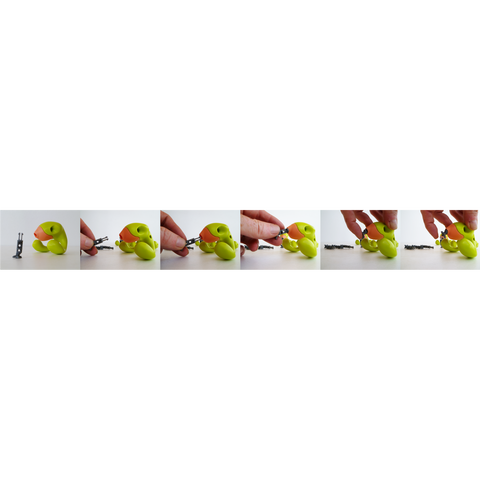ANSWERS!
What is the Biki®?
The Biki is a playful, safe and original tool-toy. It allows children over 3 years old to cut paper, while giving them great freedom of movement... and creation. Its grip is excellent thanks to its round shape specially adapted to the size of their hands. This roundness and stability (the Biki rests on three points) allows you to concentrate on the cutting gesture when it is necessary to make curves, unlike scissors requiring great dexterity for this.
 Where
Where 
Is Biki a cutter?
The idea of a classic cutter is obviously totally incompatible with the notion of safety, specific to fun, educational or artistic activities for children! The Biki could however be likened to a stable and non-dangerous cutter. Biki is a cutting toy tool.
Is there a risk of injury?
The blade protection system (patented) allows the Biki to cut paper only and avoids any risk of injury by preventing any deep penetration of the epidermis. The tool-toy is therefore 100% secure.

Why the name "Biki"? The name Biki comes from a phonetic translation of the diminutive of the word "Beak" (beak in French): "Beaky" (small beak). Biki looks like a little bird to many children!

What is Bclik?
The Bclik is the essential small cutting part. Bclick is interchangeable. It is impossible to remove the blade from its plastic protection and therefore it can be handled without danger. This is inserted into the "beak" of the Biki with a simple click. To extract it pull hard. The low protrusion of the tip of the blade, as well as the presence of plastic materials around it, guarantee stable support on the sheet to be cut and prevents any penetration of the epidermis.

Why does Biki comply with toy standards?
These are more demanding than tool standards, and guarantee safety for children. What do the standards in 71-1, 71-2, 71-3 indicated in the test report correspond to? 71-1: Mechanical behavior, 71-2: Fire behavior, 71-3: Migration and detection of certain metals.
What is the duration of use of the Bclik?
The cutting part of the Bclik, like any conventional blade, is subject to wear. This, under normal conditions of use (cutting of paper and plastic sheets on a suitable cutting support) has a lifespan of approximately 15 hours!
Is a cutting support necessary?
Yes: It is important to remember that protection of the blade and the table is necessary. A cardboard plate such as those found in craft shops or sites, framing materials, fine arts, DIY, etc. Semi-flexible plastic plates (polypropylene), rubber can also be used. Otherwise, everyone must have an old calendar, cardboard posts or very thick paper. Cellular plastic sheets, corrugated cardboard, flexible foams, or fibrous materials are not suitable. Cutting mats offered by craft supply stores are also recommended.
What makes the Biki different from school scissors?
The gesture is different from that of the scissors. Biki is 100% secure and can be within the reach of children without any special supervision, which differentiates it from scissors. It allows you to create in a more intuitive and spontaneous way. One of the great advantages of the Biki also lies in the possibility of starting the cut at any point on the sheet. No need to start from the edge!
look
Where does the Biki come from?
Biki is designed and manufactured in France (design: Arnaud Sénési), which guarantees a guarantee of quality and safety. At what age can children use the Biki? Between 7 and 10 years old : - Very fast learning and intuitive use without an adult. They manage to handle the tool very well; perfect for this age group. Between 5 and 7 years old : - The child will be able to express himself intuitively after supervision by an adult in learning and handling. Between 3 and 5 years old : - Intuitive learning. However, the help of an adult is necessary.
Can my children see it at school?
Yes, Biki is sold to schools by SAFETOOL Does the Biki cut fabric? Biki only cuts non-woven fabric. The classic fabric cannot be cut with the Biki just like with a classic cutter. We plan to develop a system of blades adapted to the fabric. What is the maximum thickness that can be cut? Drawing paper (Canson type) which is quite dense, can be cut, within a weight limit of around 160g. A denser paper (wallpaper type) but thick is sometimes easier to cut. What type of cuts can be made with the Biki? As a priority: - Free cuts For straight cuts, a guide may be necessary? Yes, but there is a (new) version with a fixed blade (Bclik).
